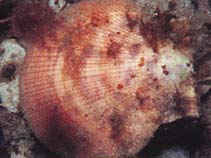Chlamys islandica (Müller, 1776)
Iceland scallop| Native range | All suitable habitat | Point map | Year 2050 |

|
| This map was computer-generated and has not yet been reviewed. |
| Chlamys islandica AquaMaps Data sources: GBIF OBIS |
رده بندی / Names اسامي عام | مترادف | CoL | ITIS | WoRMS
Bivalvia | Pectinida | Pectinidae
Environment: milieu / climate zone / تغييرات عمق / distribution range بوم شناسي
; تغييرات عمق 4 - 250 m (مرجع 3710), usually 40 - 100 m (مرجع 106788). Polar; ? - 15°C (مرجع 3706), preferred 10°C (مرجع 107945); 82°N - 32°N, 180°W - 180°E
Distribution كشورها | مناطق سازمان خوار و بار جهاني (FAO) | Ecosystems | ظهور | معرفي
Atlantic Ocean, Pacific and the Arctic: UK and Canadian Arctic Archipelago, Alaska to USA and Japan. Subtropical to polar.
Length at first maturity / Size / Weight / سن
بلوغ: Lm ? range ? - ? cm Max length : 11.0 cm SHL جنس نر / بدون خواص جنسي; (مرجع 78075); بيشينه سن گزارش شده: 23 سال ها (مرجع 8702)
Life cycle and mating behavior بلوغ | تولید مثل | تخم ریزی | Eggs | Fecundity | Larvae
مآخذ اصلی
مراجع | هماهنگ كننده | همكاران
Wiborg, K.F. 1963 Some observations on the Iceland scallop Chlamys islandica (Müller) in Norwegian waters. Fiskeridirektoratets Skrifter Serie Havundersogelser 13:38-53. (مرجع 3710)
وضعيت در فهرست قرمز IUCN
(مرجع 130435: Version 2025-1)
وضعيت از نظر سايتس (مرجع 108899)
CMS (مرجع 116361)
خطر برای انسان ها
استفاده انسانی
ماهي گيري – شيلات: تجاري
FAO - ماهي گيري – شيلات: landings | FishSource | Sea Around Us
ابزارها
اطلاعات بيشتر
منابع اينترنتي
BHL | BOLD Systems | CISTI | DiscoverLife | FAO(ماهي گيري – شيلات: ; publication : search) | Fishipedia | GenBank (ژنوم, نوکلئوتيد) | GloBI | Gomexsi | Google Books | Google Scholar | Google | PubMed | Tree of Life | Wikipedia (برو, جستجو) | Zoological Record



